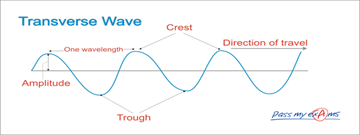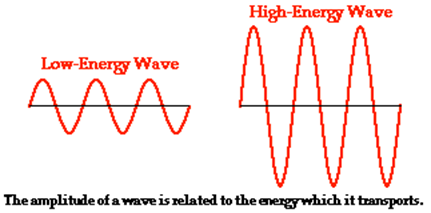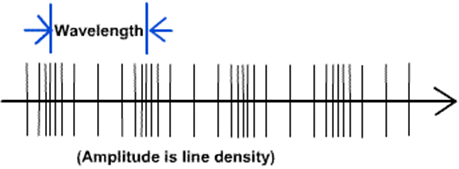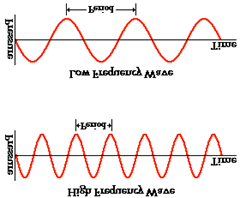Chapter 11 Notes- Waves
11.1- The Nature of Waves
Wave- a repeating disturbance or movement that transfers energy through matter or space
-All waves have to made from something that vibrates
-Waves can only carry energy
- Waves go through matter they don’t carry it
Ex- Water waves just push the water up and when the energy moves on the water drops down and circles back to where it began
Mechanical Wave- wave that has to travel through a Medium
-Medium is a solid, liquid, gas or any combination of these
* Not all waves have to go through a medium like light or radio waves but these are not mechanical waves
There are 2 types of mechanical waves:
1. Transverse waves- matter in the medium moves back and forth at right angles in the direction that the wave travels.
2. Compressional waves- matter in the medium moves back and forth in the same direction that the wave travels like a sound wave, slinky, radar, or a sonic wave.
-Sound waves are compressional waves, but they can go through different mediums, which affects the speed of the wave.
For example- someone is yelling at someone swimming underwater that a shark is coming. The compressional wave has to travel (slowly) through the air, and then moves (faster) through the water.
- A combination wave is not purely transverse or compressional, but a combination of both of these. Seismic waves (earthquake) are combination waves.
11.2 Notes- Wave Properties
Waves differ in 3 ways
1. How much energy they carry
2. How fast they travel
3. How they look
Each type of mechanical wave has different parts that correspond to they other type of mechanical wave.
-Transverse waves have 3 main parts.
a. Crests- highest points on a wave
b. Troughs- lowest points on a wave
c. Rest position- the place in between a crest and a trough where the medium would rest if there were no energy passing
 -
-
- Compressional waves have 2 main parts
a. Compressions- dense regions where the medium is smooshed together
b. Rarefactions- less dense region where the medium is spread apart
Draw a compression & rarefaction below:
*Compressions correspond to crests & rarefactions correspond to troughs

Wavelength (l)- the distance between one point on a wave the next point on a wave just like it. (Ex- crest to crest; trough to trough; compression to compression; rarefaction to rarefaction)
*The # of crest/compressions etc can tell you how many wavelengths there are by subtracting 1 from the total # of compressions/crests * See Below:

Amplitude- The measure of energy in a wave
-The more energy a wave carries the greater its amplitude
1. In transverse waves you measure amplitude by how high/low the crest/trough is from the rest position.
a. The higher the crest the more energy the wave is carrying.

2. In a compressional wave the amplitude is measured by how tightly the compression is pushed together

Frequency (f)- How many wavelengths pass a fixed point each second.
1. Frequency is expressed in Hertz (Hz)
2. As frequency increases wavelength decreases
3. The frequency of a wave equals the rate of vibration of the source that creates the wave.

Top picture has a frequency of 5 Hz
Bottom picture has a frequency of 2 Hz
Wave Speed (s)- How fast the wave is moving forward.
* Depends on the properties of the medium the wave is going through.
Ex- light waves travel faster than sound waves. Sound waves move faster through liquids and solids than gases. Whereas light waves travel faster through gases and empty spaces faster than solids or liquids
1. Wave speed can be calculated by multiplying the frequency of the wave by the wavelength
a. s= l · f
b. s is measured in meters per second (m/s)
c. l is measured in meters (m)
d. f is measured in Hertz (Hz) which is 1/s
Source: http://isite.lps.org/wmartin/web/documents/Chapter11Notes_000.doc
Web site to visit: http://isite.lps.org/
Author of the text: indicated on the source document of the above text
If you are the author of the text above and you not agree to share your knowledge for teaching, research, scholarship (for fair use as indicated in the United States copyrigh low) please send us an e-mail and we will remove your text quickly. Fair use is a limitation and exception to the exclusive right granted by copyright law to the author of a creative work. In United States copyright law, fair use is a doctrine that permits limited use of copyrighted material without acquiring permission from the rights holders. Examples of fair use include commentary, search engines, criticism, news reporting, research, teaching, library archiving and scholarship. It provides for the legal, unlicensed citation or incorporation of copyrighted material in another author's work under a four-factor balancing test. (source: http://en.wikipedia.org/wiki/Fair_use)
The information of medicine and health contained in the site are of a general nature and purpose which is purely informative and for this reason may not replace in any case, the council of a doctor or a qualified entity legally to the profession.
The texts are the property of their respective authors and we thank them for giving us the opportunity to share for free to students, teachers and users of the Web their texts will used only for illustrative educational and scientific purposes only.
All the information in our site are given for nonprofit educational purposes